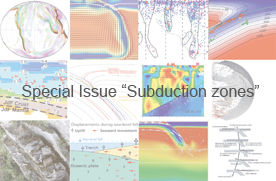Numerical models of slab migration in continental collision zones
Abstract. Continental collision is an intrinsic feature of plate tectonics. The closure of an oceanic basin leads to the onset of subduction of buoyant continental material, which slows down and eventually stops the subduction process. In natural cases, evidence of advancing margins has been recognized in continental collision zones such as India-Eurasia and Arabia-Eurasia. We perform a parametric study of the geometrical and rheological influence on subduction dynamics during the subduction of continental lithosphere. In our 2-D numerical models of a free subduction system with temperature and stress-dependent rheology, the trench and the overriding plate move self-consistently as a function of the dynamics of the system (i.e. no external forces are imposed). This setup enables to study how continental subduction influences the trench migration. We found that in all models the slab starts to advance once the continent enters the subduction zone and continues to migrate until few million years after the ultimate slab detachment. Our results support the idea that the advancing mode is favoured and, in part, provided by the intrinsic force balance of continental collision. We suggest that the advance is first induced by the locking of the subduction zone and the subsequent steepening of the slab, and next by the sinking of the deepest oceanic part of the slab, during stretching and break-off of the slab. These processes are responsible for the migration of the subduction zone by triggering small-scale convection cells in the mantle that, in turn, drag the plates. The amount of advance ranges from 40 to 220 km and depends on the dip angle of the slab before the onset of collision.






